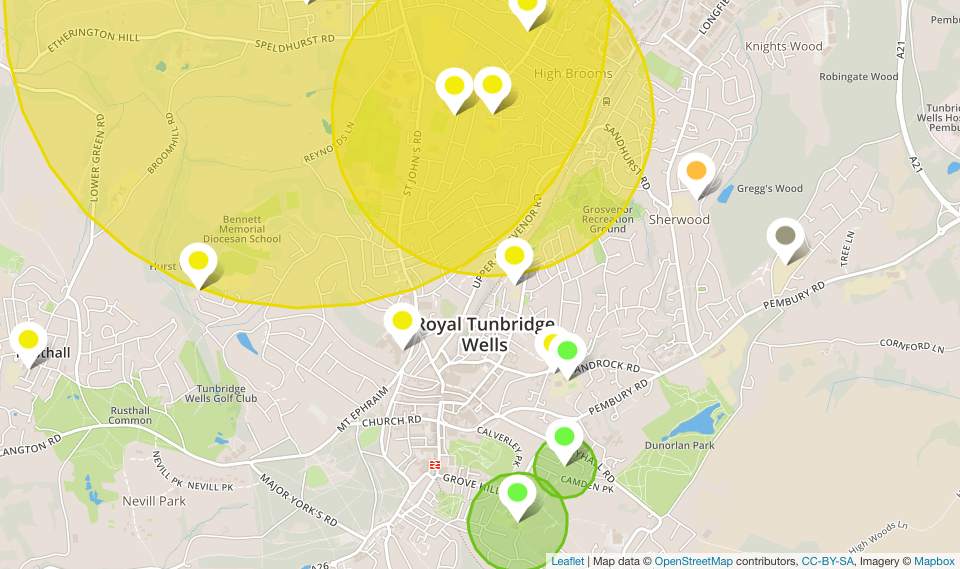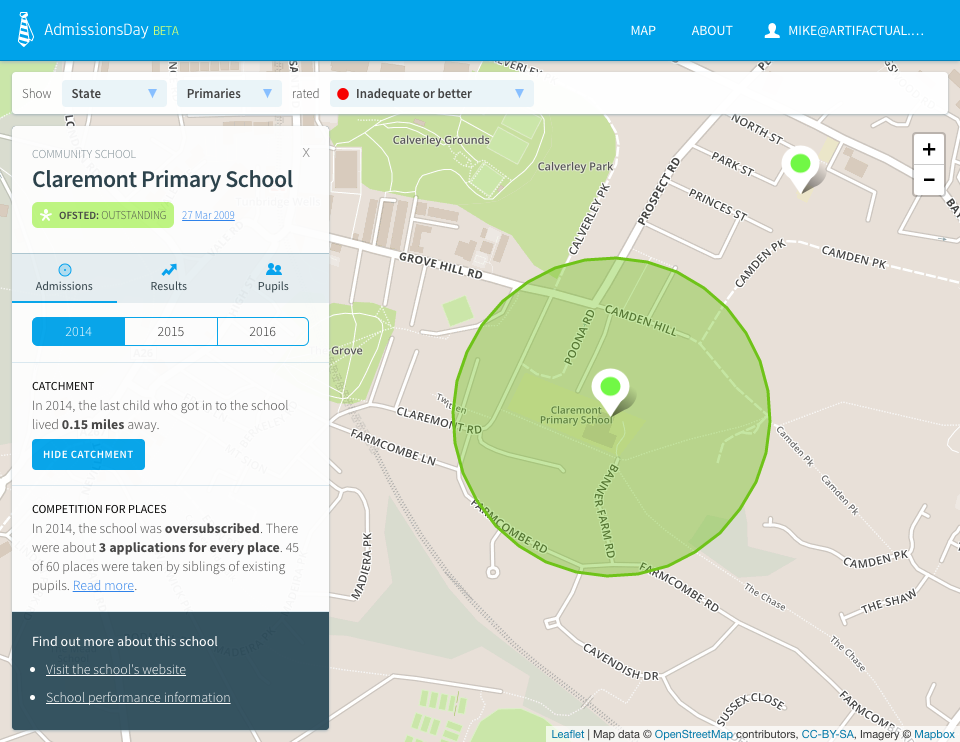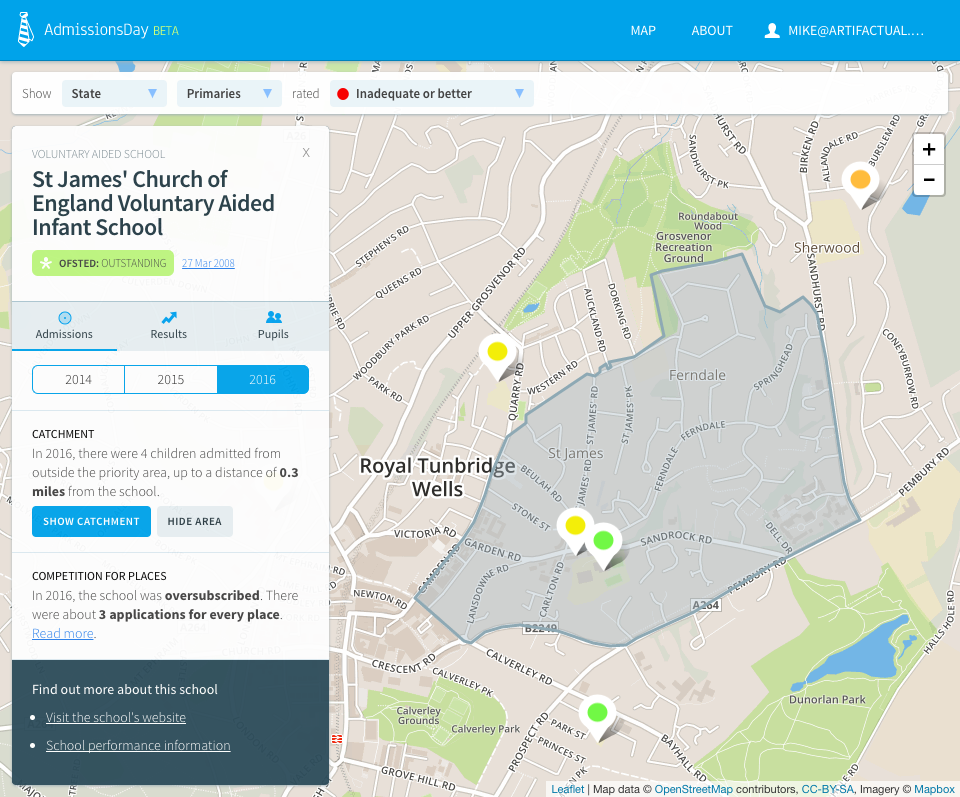How do primary school admissions work in Kent?

Short on time? Read this first
These three points are the main things to consider when applying for a primary school in Kent.
- Criteria: most children get into a school based on being a sibling of an existing pupil or living near the school. About half of primary schools in Kent have extra criteria that give certain groups an advantage — make sure you research these criteria for the schools you're interested in to see how they might affect you.
- Catchments: most schools don't have fixed catchments, and the geographical area from which they admit pupils changes every year. For most primary schools in Kent, their effective catchment areas are circles that can change in size from year to year. The historical sizes of these catchments are a good guide to what might happen but aren't foolproof and should only be treated as estimates.
- Applications: in Kent, you only get three choices. The order you put them in doesn't affect how the school treats you. Don't waste a preference on a school that's a long way away unless you child is likely to be given a place under a different criteria such as religious affiliation.
I moved house to Tunbridge Wells in Kent about three years ago. At the time, my son was 1.5 years old and my wife and I didn't think about schools until it was too late to really do so properly. Bad parents, clearly.
There was much rushed reading of obscure PDF files on the council website, but ultimately we made our decision about where to buy without really being properly informed.
This experience led me to create AdmissionsDay.co.uk, and as well as learning a huge amount about how school admissions and catchments work, I’ve also learned that they're a bit of mystery to a lot of people. I made AdmissionsDay.co.uk to try and remove this mystery.
This article aims to describe how the admissions process works for primary schools in Kent.
1. Admissions criteria
Every school has a set of criteria that they use to decide which children to admit. There are about 450 primary schools in Kent, and around half of them follow the rules laid down by Kent County Council. The others are academies, free schools and religious schools and can set their own criteria.
In reality though, the criteria for almost all schools have a lot in common, and the majority of children will be admitted based on them being siblings of an existing pupil, or based on how close they live to the school.
But individual schools (the academies, free schools and religious schools mentioned earlier) can set their own criteria. For example:
- Skinners Kent Academy in Tunbridge Wells gives priority to children of staff over children who live nearby
- Lady Boswell’s C of E school in Sevenoaks prioritises children "whose parents are committed to St Nicholas Parish Church"
If you’re considering applying to a school, you need to find and understand these criteria. If you purchase access to AdmissionsDay, you also get access to direct links to the admissions pages of around 95% of all schools that set their own admission policies.
An example
So, let’s imagine that a school has 60 places on offer and receives 208 applications. Imagine then that 40 of these applications are from brothers or sisters of existing pupils. This only leaves around 18 places (let’s say a couple were taken by children in local authority care) left for the other applicants. In fact, this is what happened at Claremont Primary School in Tunbridge Wells in 2016, which is one of the most popular schools in the county.
The remaining 166 applicants were then ranked by how far away they live from the school (the distance is measured in a straight line from house to school, rather than based on the shortest walking route) and the top 18 are given places — all 18 lived within 300 metres of the school.
2. What about catchments?
For the majority of primary schools in Kent, there are no catchments — no predefined areas from which a school takes its pupils.
In fact, the geographical area from which a school admits its pupils changes every year.
In the example of Claremont above, the last child of the 18 admitted based on how far away they live, lived 0.185 miles from the school.
This distance represents a kind of effective catchment area for that year: if you’d lived closer you’d have got in. For most primary schools in Kent, this effective catchment is a circle that changes in size each year. An example for Claremont from 2014 is shown below.

These areas change year by year for each school, varying based on the number of places given to siblings and the popularity of the school. Sometimes they can change by a large amount, becoming smaller if there's a sudden influx of siblings one year, or bigger if a school increases its capacity.
With AdmissionsDay, we're trying to record these catchment circles for as many state primary schools as we can, so paying users of the site can see how they have changed over time.
Some schools — like St James’ C of E Infant School in Tunbridge Wells — do actually have priority admission areas. If you live in one, you’ve definitely got an advantage over someone who doesn’t as applications from within these areas are prioritised over applications outside, even if they're further away. But you're still not guaranteed a place, as a surge in sibling applications one year can lead to increased competition. We've added the priority admission area for St James C of E Infant School to AdmissionsDay.co.uk:

(If you know another school in Kent that has one, let us know and we'll try and add it in.)
3. Why does all of this matter?
When you apply to a primary school in Kent, you have space to list three preferences — three schools that you would like your child to go to. The order you put these preferences in has no impact on how a school treats your application, but if your child is eligible to go to say both your first and second preference, you will only be offered the place at your first preference.
We're collecting the data on how many applications or preferences each school receives every year, so you can see how the popularity of a school has changed over time. For about 50% of primaries in Kent, we can also tell you how many places were taken each year by siblings.
It's important to understand the criteria and effective catchments of different schools for a couple of different reasons:
- If you're not planning on moving, you need to know at which schools your child actually has a chance of being offered a place, so you don't waste a preference on a school that's too far away to get into.
- If you're looking to change where you live, you need to know what the effective catchments have been in the past. It's not a fool-proof way of ensuring admission as they change every year, but it's a good guide, and much better than an estate agents' typically hand-wavey claims about proximity.
Explore school admissions and catchments near you
Enter a postcode, street or town to get started
Summary
So, to repeat what I said at the start, there are three main things to consider when applying for a primary school in Kent:
- Criteria: most children get into a school based on being a sibling of an existing pupil or living near the school. About half of primary schools in Kent have extra criteria that give certain groups an advantage — make sure you research these for the schools you're interested in to see how they might affect you.
- Catchments: most schools don't have fixed catchments, and the geographical area from which they admit pupils changes every year. For most primary schools in Kent, their effective catchment areas are circles that can change in radius from year to year. Historical values are a good guide but aren't foolproof and should only be treated as estimates.
- Applications: in Kent, you only get three choices. The order you put them in doesn't affect how the school treats you. Don't waste a preference on a school that's a long way away unless you child is likely to be given a place under a different criteria such as religious affiliation.